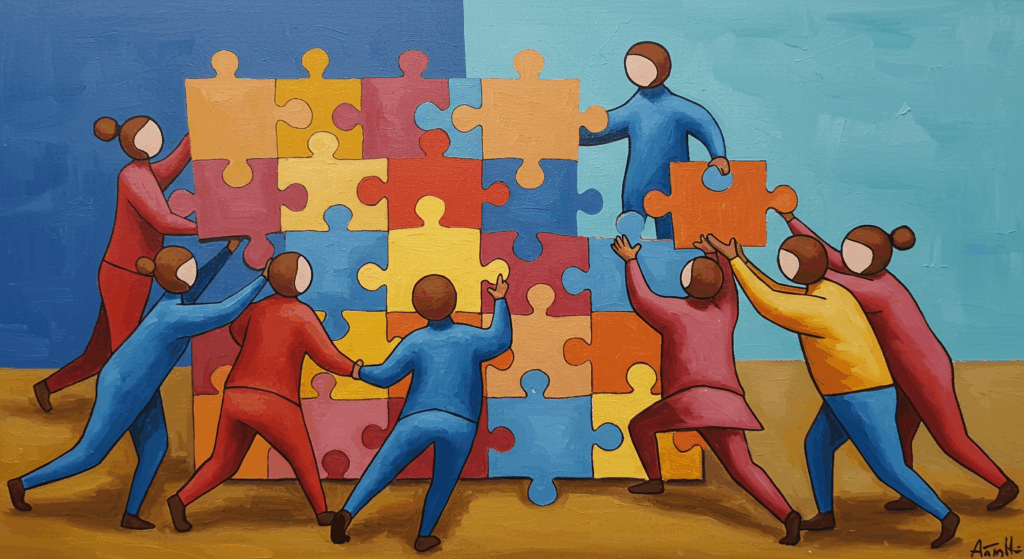Most of us know that, a lot of team building at work is… painful. Like forced-fun painful. Trust falls in a conference room at 4 pm? No thanks, my calendar just got full with “staring into the void.” But hear me out—when team building is done with actual humans in mind (hi), it can be the difference between “quiet quitting” energy and “yo, we’re kinda unstoppable” vibes.
This guide is your friendly, non-cringe toolbox of team building activity ideas for work that real people will actually enjoy—Gen Z, Millennials, everyone who knows the weird ache of switching between five Slack channels and a Gogle Meet. We’ll talk office games, workplace challenges, and practical team exercises you can plug into your week without derailing productivity or your sanity. Expect casual asides, tiny imperfections (because… real life), and activities that scale from 3 people to 300.
Grab your iced coffee. Let’s build a team that actually wants to be a team.
Why Team Building Isn’t a Cringe Festival (When You Do It Right)
Most teams aren’t struggling because they hate each other (okay, sometimes there’s a villain arc, but usually not). The issues are more like:
- Miscommunication (slack pings, vague emails, the classic “quick question” that is never quick)
- Low trust (no one wants to ship bold ideas if they’re scared of getting roasted)
- Unclear roles (three people did the same task and now you have three slightly different spreadsheets)
- Energy drain (no fun, no spark, all grind, rinse repeat)
Team building—done right—touches those pain points. The point isn’t a party. It’s intentional time that nudges your crew to talk, solve, and experiment together. Bonus: it makes meetings less awkward. Double bonus: it can be fun, like… actually fun.
The Vibe Check: Principles for Non-Cringe Team Building
- Make it opt-in where possible. Give alternative roles—facilitator, timekeeper, judge—so introverts don’t feel forced into loud spotlight moments.
- Tie it to something real. Activities land harder when they mirror a work dynamic: handoffs, creative ideation, feedback loops.
- Short and sweet wins. 15–45 minutes beats anything that hijacks an entire afternoon. (Unless it’s a retreat—then go big, but plan well.)
- Debrief or it didn’t happen. Always include 5–10 minutes to ask: What worked? What was chaotic? What did we learn about each other?
- Rotate ownership. Let different teammates host the next activity. Great for leadership growth, also it keeps things fresh.
Alright, time to get into the actual office games, workplace challenges, and team exercises you can try next week—some today.
Office Games That Don’t Suck (And Actually Build Skills)
These are quick, low-prep, and perfect for energizing a meeting or resetting the vibe midweek.
1) Emoji Check-In (5 minutes, hybrid-friendly)
Each person shares three emojis that represent their current mood and workload. Example: 😵💫🧃🚀 (overloaded, juice break, launch mode).
Why it works: Fast emotional calibration; surfaces capacity without a formal status report.
Pro tip: Save the emoji history in a shared doc. Patterns tell stories.
2) Two Truths and a Stretch Goal (10 minutes)
A twist on an old classic. Each person says two true facts about themselves and one “stretch goal” they’re chasing this quarter (work or personal).
Why it works: Helps teammates cheer each other on; creates light accountability.
3) Silent Storyboarding (15–20 minutes)
Share a Miro board or a physical whiteboard. Everyone draws (no words!) the current project journey from “idea” to “shipped.” Then present.
Why it works: Forces clarity. Reveals unspoken assumptions. And yes, stick figures are art.
4) The 1-Minute Pitch Roulette (10–15 minutes)
Spin a wheel with random product ideas (“self-watering hoodie,” “AI potato peeler,” “coworking jungle office”). Each person gets 60 seconds.
Why it works: Builds confidence; sharpens articulation under time pressure; hilarious chaos.
5) Desk Safari (Remote, 10 minutes)
Everyone grabs an object nearby and connects it to their role. “This stapler is like my QA checklist—holds everything together when chaos wants to escape.”
Why it works: Playful metaphor-building; sparks empathy for different roles.
6) Micro Charades: Office Edition (10 minutes)
Create cards with common work activities (“updating Jira,” “renaming files,” “Zoom freeze face”). Act them out fast.
Why it works: Shared laughter = social glue. Also, you’ll never forget “Zoom freeze face.”
These office games are small, but they set a tone: it’s okay to be human here. And fun fact—humans who laugh together solve problems faster.
Workplace Challenges: Friendly Competition That Drives Real Growth
Competition can’t be the whole culture, but done well, workplace challenges light a fire under skill growth and collaboration.
7) Inbox Zero Sprint (30 minutes)
As a team, set a timer. Everyone clears a chunk of email/Slack/Tickets.
Score: Before vs. after counts.
Why it works: Shared momentum. Instant gratification. Less mental clutter.
8) Documentation Scavenger Hunt (20–30 minutes)
Create a list (“Find the onboarding checklist,” “Locate API rate limit info,” etc.). First team to find all links wins.
Why it works: Teaches where the info lives. Turns docs into an adventure (kinda).
9) Bug Bash League (1–2 hours, monthly)
Everyone (not just engineers) hunts for UX bugs or content inconsistencies.
Score system: 1 point small, 3 medium, 5 critical; bonus for clear repro steps.
Why it works: Quality becomes everyone’s job. Also makes the product feel “ours.”
10) Process Glow-Up Challenge (1 week)
Each person nominates one workflow to simplify (e.g., recurring report). The team votes on the best glow-up. Winner demos the fix.
Why it works: Continuous improvement becomes a game. Time saved is time saved.
11) The 5-Day Customer Love Sprint
For five days, pair up across teams (e.g., designer + support rep). Each pair does one small action daily to improve customer happiness—micro-content, tiny UI copy polish, faster FAQ answers, etc.
Why it works: Cross-functional empathy + tiny wins = big vibe shift.
12) Accessibility Check Challenge (45 minutes)
Give teams a checklist (contrast ratios, keyboard navigation, alt text, heading order). Score inprovements made.
Why it works: Builds a more inclusive product and culture in one go.
Do these workplace challenges monthly. Keep a scoreboard, give light prizes (coffee gift cards, a plant, a vinyl—whatever your office vibe is), and showcase wins in all-hands.
Team Exercises for Trust, Communication, and Problem-Solving
These team exercises go deeper than micro-games. They build the muscles that matter long-term.
13) Roles & Expectations Retro (40–60 minutes)
Use a template with four columns: “What I own,” “What I think you think I own,” “I need from others,” “What I offer others.”
Flow: Each person fills it silently, then discuss overlaps and gaps.
Outcome: Clarity. Less accidental stepping on toes.
14) The Hand-Off Drill (30 minutes)
Split into pairs. Person A explains a task they just finished; Person B writes the checklist they would have needed to do it right the first time. Compare.
Outcome: Better briefs, cleaner handoffs, fewer “ohhh I didn’t know that” moments.
15) Friction Mapping (45 minutes)
On a board: To-Do → In Progress → Review → Done. Everyone adds sticky notes for friction points. Group them. Prioritize top 3 to fix this week.
Outcome: A de-clogged pipeline. It’s basically therapy for your workflow.
16) Failure Postcards (30 minutes)
Each person writes a short “postcard” to the team about a time they messed up at work and what they learned. Share a few (voluntary).
Outcome: Psychological safety. Normalizes learning instead of blame.
17) Customer Journey Theater (45–60 minutes)
Assign roles: new user, returning user, support, marketing, engineer. Act out a typical customer journey.
Outcome: Empathy; crazy insights (“Wait, our sign-up email still says ‘Hello ,’ with a missing name?”). Fix fast.
18) The Constraint Sprint (60–90 minutes)
Give a real problem but force constraints (no email, 2 hours only, budget $50).
Outcome: Creativity under pressure, scrappy execution, better prioritization.
19) Feedback Speed-Dating (30 minutes)
Pairs rotate every 5 minutes. Prompts: “One thing I appreciate about you,” “One way I think you could level up next quarter.”
Outcome: Real feedback in a safe, short format. Keep it kind and actionable.
Creative Office Games for Idea Generation
When your team needs fresh thinking (hello, empty whiteboard), try these.
20) The Playlist Workshop (30–45 minutes)
Ask everyone to bring a 30-second song snippet that matches your project mood (Spotify makes this easy). Discuss: what feeling do we want users to have?
Outcome: Shared creative direction. Also: music. Always a win.
21) Bad Ideas Bake-Off (25 minutes)
Everyone writes intentionally terrible ideas for the current project. Then remix them into good ones.
Outcome: Fear-free creativity. Sometimes the “bad” idea has a great core.
22) Meme-ify the Message (20 minutes)
Teams turn a complex concept into a meme (with respectful humor). Present and vote.
Outcome: Sharpens messaging; turns jargon into something shareable.
23) Poster to Pull Request (45–60 minutes)
Design a one-page poster advertising your upcoming feature internally (headline, benefit, proof). Then translate it into a mini spec or task list.
Outcome: Vision → execution bridge. Marketing meets engineering meets product.
Hybrid & Remote-Friendly Team Exercises (Because Time Zones Are Real)
24) Async Show-and-Tell (Slack Thread, 1–2 days)
Prompt: “Show a 15-sec screen recording of your top keyboard shortcut or tiny productivity trick.”
Outcome: Knowledge sharing with zero meeting bloat.
25) Virtual Escape Room Lite (30–45 minutes)
DIY version: build a Google Doc puzzle sequence (ciphers, hidden links, code fragments).
Outcome: Problem-solving, collaboration, lightweight fun.
26) Coffee Roulette (15 minutes)
Use a bot or spreadsheet to pair people across departments for quick chats.
Outcome: Weak ties get stronger—those random hallway convos, but remote-ified.
27) Loom Book Club (30 minutes async + 15 sync)
Each person records a 3-minute Loom summarizing a short article or podcast. Then a 15-minute live huddle to connect dots.
Outcome: Scales knowlledge without giant meetings.
Micro Wellness Moments (Because Burnout Is Sneaky)
28) Two-Breath Reset (2 minutes)
At the start of big meetings: eyes open, two slow breaths together. That’s it.
Outcome: Decreases cognitive noise. Feels a little silly, works like magic.
29) Walk & Talk (15 minutes)
Audio-only 1:1s while walking.
Outcome: Fresh air + movement = better conversations.
30) Gratitude Loop (10 minutes)
Go around and name one thing you appreciate about the team this week.
Outcome: Positivity that doesn’t feel forced. (Ngl, it can be sweet.)
Workplace Challenges That Spark Learning (Nerdy but Fun)
31) Teach-Back Tuesdays (20 minutes)
Rotate micro-lessons: Figma tips, SQL basics, better slide design, storytelling hacks.
Score: Light points for clarity & usefulness.
Outcome: Culture of “we teach each other.”
32) Data Treasure Hunt (30 minutes)
Create 5 questions answerable only by your analytics dashboards. First team to find accurate answers wins.
Outcome: Demystifies data. Faster insights later.
33) Shadow Swap (2–3 hours per month)
A marketer shadows a support call. An engineer watches user testing. A PM joins a sales call.
Outcome: Alignment. Less “us vs. them,” more “we’ve got one user.”
Team Exercises That Build Trust (Without Forced Vulnerability)
34) Work Autobiographies (30 minutes)
Each person shares their “work origin story”: first job, weird detours, biggest pivot.
Outcome: Respect for the path, not just the title.
35) Decision Debriefs (20 minutes)
After a major decision, debrief the criteria used, trade-offs chosen, and what would change the decision next time.
Outcome: Transparency; faster buy-in.
36) The “No” Workshop (30–45 minutes)
Practice saying no kindly. Roleplay scenarios: misaligned requests, scope creep, unrealistic timelines.
Outcome: Boundaries as a team sport. Less burnout.
Budget-Friendly Office Games (Because Not Every Team Has Retreat Money)
37) Paper Prototypes (30 minutes)
Design a new onboarding flow using paper and pens. Test with teammates.
Outcome: Rapid iteration. Zero software required.
38) 5-Minute Hack Demos (15 minutes total)
Each person shows a tiny improvement (macro, Shortcut, snippet).
Outcome: Cumulative magic. Small riffs, big time savings.
39) Guess the Desk (10 minutes, remote)
Post a cropped photo of someone’s workspace. Guess whose.
Outcome: Laughter + light bonding; shows personality without oversharing.
High-Energy Team Building for Offsites (Go Big, Be Smart)
40) The Great Product Relay (90 minutes)
Teams cycle through stations: brainstorm branding, write micro-copy, sketch UI, define metrics, pitch.
Outcome: End-to-end thinking; cross-skill appreciation.
41) Field Day Reimagined (2–3 hours)
Rotate physical-ish activities like giant Jenga, “egg” (ping-pong ball) drop, puzzle sprints.
Outcome: Movement + brains; low intimidation if you keep it friendly.
42) Volunteer Challenge (2–4 hours)
Pick a cause and set measurable goals (e.g., assemble 100 care kits).
Outcome: Purpose unlocks a different kind of team energy.
Bringing It All Together: A Simple Quarterly Playbook
Let’s make this practical. Here’s a lightweight rhythm you can copy/paste and adapt.
Weekly (15–30 min total)
- One quick office game to warm up a meeting (Emoji Check-In, Micro Charades).
- One micro learning or share-out (5-Minute Hack Demos, Teach-Back Tuesdays).
Monthly (60–90 min)
- One workplace challenge (Bug Bash League, Process Glow-Up).
- One deeper team exercise (Roles & Expectations Retro, Friction Mapping).
Quarterly (Half-day)
- Offsite-lite or virtual summit (Great Product Relay + Volunteer Challenge + Decision Debrief of the quarter’s biggest call).
Always (5–10 min)
- Debrief every activity: “What did we notice? What changes this week?”
This cadence respects calendars and still compounds into real culture change.
How to Measure If This Stuff Works (Without Killing the Vibe)
Okay, metrics people, I see you. If you want receipts that your team exercises and workplace challenges are doing something, track:
- Participation rate: How many folks show up voluntarily?
- Meeting health: Fewer “this could’ve been an email,” more “decisions made.”
- Cycle time: Does work move from To-Do → Done faster after friction mapping?
- Cross-team DMs: More helpful messages, fewer “who owns this?” threads.
- Pulse surveys: One question per month—“I feel safe sharing half-baked ideas” (1–5).
- Retention & referrals: Do people stay and recommend others to join?
No need to make it a science experiment. Just notice the trend lines.
Common Mistakes to Avoid (So You Don’t Accidentally Create Rage)
- Over-engineering it. If your “fun” requires a 27-slide deck, it’s not fun.
- One-size-fits-all. Vary for introverts/extroverts, remote/in-office, roles, abilities.
- Skipping the debrief. Without reflection, it’s just noise.
- Tying rewards to serious perks. Keep prizes light so it doesn’t get political.
- Using team building to dodge real fixes. Activities won’t save a toxic process. Fix the process.
Sample 60-Minute Team Session You Can Run Tomorrow
Here’s a plug-and-play agenda that blends office games, workplace challenges, and team exercises:
0–5 min: Emoji Check-In
Fast pulse read. Pop them in chat or say them out loud.
5–20 min: Hand-Off Drill
Pairs draft checklists based on a recent task. Compare and refine.
20–40 min: Friction Mapping
Identify top 3 blockers. Assign owners with next steps.
40–55 min: Bad Ideas Bake-Off
Go wild on “bad” solutions to a real problem. Remix the best for action.
55–60 min: Debrief & Commit
Each person states one tiny action they’ll take this week.
This is lean, human, and immediately useful. No trust falls sacrificed.
Accessibility & Inclusion Notes (Because Everyone Should Get to Play)
- Offer multiple modes: talk, type, draw. Let people choose.
- Caption your videos and use tools that support keyboard nav.
- Check time zones and rotate meeting times for global crews.
- Mind sensory load: avoid loud surprises, bright flashes.
- Pronouns & names: normalize intros that include how to say your name.
- Food & events: ask about dietary needs and mobility access when planning in-person activities.
Inclusion isn’t a side quest. It’s the main storyline.
Curating Your Own Menu of Office Games, Workplace Challenges, Team Exercises
Treat your activity list like a Spotify playlist: stuff you love, skip the tracks that don’t fit the room. Create categories in a shared doc:
- Warm-Ups (5–10 min): Emoji Check-In, Desk Safari
- Skill Builders (15–30 min): 1-Minute Pitch Roulette, Teach-Back Tuesdays
- Process Fixers (30–60 min): Friction Mapping, Hand-Off Drill, Accessibility Check
- Creative Sprints (20–45 min): Bad Ideas Bake-Off, Meme-ify the Message
- Community Boosters (20–60 min): Coffee Roulette, Volunteer Challenge
Rotate through based on what your team needs this month. If you’re in launch mode, lean into quick check-ins and process fixers. If you’re post-launch, go creative and celebratory.
Real Talk: Getting Buy-In From Skeptics
There’s always someone who’s like, “I have real work.” Fair. Try this:
- Start small. 10 minutes at the top of standup.
- Show quick value. “We shaved 20% off review time after Friction Mapping.”
- Invite ownership. “Alex, want to pick next week’s activity?”
- Never shame non-participants. Opt-in, not hostage situation.
- Connect to goals. Make the line clear: better collaboration → faster outcomes → less stress.
Once people see it isn’t performative, resistance drops.
FAQ (Because Someone Will Ask)
Do these activities work for introverts?
Yes—when you offer roles (note-taker, facilitator), allow quiet think time, and don’t force constant performative talk.
How often should we do team building?
Light weekly + one monthly + one quarterly works for most teams. Adjust based on stress cycles.
What if leadership thinks it’s fluff?
Translate outcomes: fewer handoff errors, faster cycles, happier customers. Track a few metrics and share wins.
How do we avoid cringe?
Choose activities that solve real pain (handoffs, feedback, clarity). Keep it short, relevant, and let people opt in.
Quick-Pick List: Plug-and-Play Ideas by Goal
Need energy fast? Micro Charades, Playlist Workshop, 1-Minute Pitch Roulette.
Fix messy processes? Friction Mapping, Hand-Off Drill, Decision Debriefs.
Boost creativity? Bad Ideas Bake-Off, Meme-ify the Message, Poster to Pull Request.
Build trust? Failure Postcards (opt-in), Work Autobiographies, Gratitude Loop.
Cross-team alignment? Shadow Swap, Customer Journey Theater, Teach-Back Tuesdays.
Remote-friendly bonding? Coffee Roulette, Async Show-and-Tell, Virtual Escape Room Lite.
Sample Add-Ons: Make It Feel Legit (But Still Chill)
- Rotating host: New person runs the activity each week.
- Tiny trophy: A $10 plant or a goofy rubber duck for the monthly challenge winner.
- Wall of Wins: A Notion page where you screenshot small victories.
- Retro emojis: Let the team vote with emojis on what to repeat or retire.
Wrapping It Up (With Zero Corporate Buzzword Salad)
Team building is not about staging a fake friendship montage. It’s about creating regular, lightweight moments where people can think, laugh, and solve problems together—so the big stuff goes smoother. Pick 2–3 office games to warm up your week, choose one workplace challenge per month to push the team’s craft, and schedule deeper team exercises every few weeks to sharpen communication and trust.
You don’t need a big budget or a consultant with a dramatic flip chart. You just need intention, ten minutes, and a group of humans who want to do great work without losing their souls (or their sense of humor).
Your move: Pick one idea from this list. Put it on the calendar for next week. Keep it short. Debrief it. Then do it again—slightly better. You’ve got this. And hey, if someone suggests trust falls… just smile, hand them a rubber duck, and invite them to the Bad Ideas Bake-Off instead.









